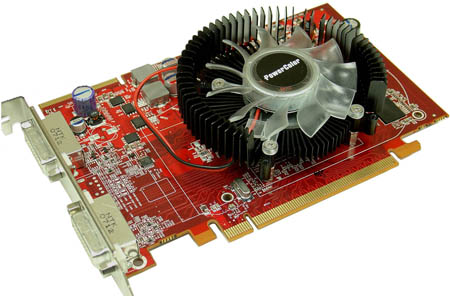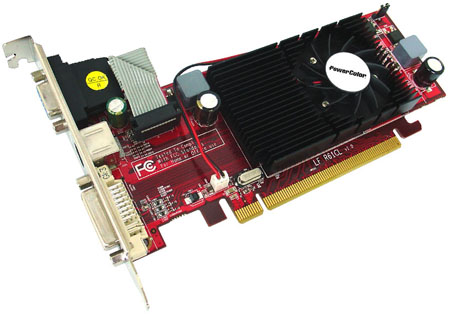Original URL: https://www.theregister.com/2007/06/28/review_powercolor_hd_2600_xt/
PowerColor ATI Radeon HD 2600 XT graphics card
AMD's HD 2600 XT and HD 2400 XT debut
Posted in Personal Tech, 28th June 2007 14:26 GMT
Review We've waited a long time for AMD's ATI Radeon HD 2400 and 2600 graphics chips. Although they were launched in May alongside the HD 2900 XT - reviewed here - it's only now that these budget and mid-range parts have gone on sale.

PowerColor's HD 2600 XT
Before we dive into our review of the PowerColor's HD 2600 XT with 256MB of GDDR3 memory and its HD 2400 XT, let's take a quick look at the features of the new chips. Both chips are manufactured using a 65nm process - called 65G+ - rather than the 80nm process used in the HD 2900. They're fully compliant with Microsoft's DirectX 10 and Shader Model 4. They all have two dual-link DVI connectors and may come packaged with an HDMI adaptor. The low power draw of the chips means that we can expect to see DirectX 10 AGP graphics cards that have no need for an additional power connector.
The key features of the HD 2400 and HD 2600 are the speed of the core and memory as well as the number of unified 'Stream' processors.
The HD 2900 has 320 stream processors and 700m transistors while the mid-range HD 2600 has a mere 120 stream processors and 390 million transistors. The memory controller of the HD 2600 is 128-bit so you'd predict that the HD 2600 would have about 35 per cent of the performance of the HD 2900.
The HD 2400 has a tiny count of 40 stream processors so the 64-bit memory controller manages to be both pathetic and ample. Back-of-the-envelope calculations tell us the HD 2400 is the equivalent of ten per cent of a 2900.
One significant feature of the HD 2400 and HD 2600 is the UVD (Unified Video Decoder) video engine. This is the dedicated piece of silicon that decodes VC-1, MPEG-2 and H.264 HD video streams without placing a burden on your processor. You don't get a UVD in the HD 2900 as the sheer grunt of the GPU allows it to manage video decoding all on its own. However, AMD messed with the initial driver release for the HD 2900 as it didn't transfer the workload for HD video decoding from the CPU to the GPU. That's been fixed now.
UVD is great provided you have either an HD-DVD or Blu-ray Disc drive in your PC, or you're in the habit of watching H.264 trailers from Apple's QuickTime website. The fact of the matter is that your reviewer doesn't watch HD and sticks with AVI and DivX on the PC, with DVD reserved for the living room and TV. Perhaps the advent of UVD will change our habits in years to come but for the time being its appeal is limited.
Incidentally, in addition to the new desktop parts, AMD also launched today a line of new Mobility GPUs that use the same silicon, although the Mobility Radeon HD 2300's name is a something of a red herring as it's a DirectX 9 part that is essentially a Mobility Radeon X1600 with the addition of a UVD.

PowerColor's HD 2400 XT
The HD 2600 XT that PowerColor sent us uses the reference core speed of 800MHz with 256MB of GDDR 3 memory that runs at a true speed of 700MHz to deliver an effective clock rate of 1400MHz.
We ran the HD 2600 XT in a test PC with a Core 2 Duo QX6800, an Asus P5K3 Deluxe motherboard and 2GB of Kingston 1100MHz DDR3 memory and found that performance in 3DMark06 and Oblivion was level pegging with a n Nvidia GeForce 8600 GT. In Half Life 2 the system restarted repeatedly with the HD 2600 XT, but performed flawlessly with the 8600 GT until we loaded the Beta drivers that we used with the HD 2400 XT, which cured the problem. so it looks as though AMD has some work to do on its Catalyst drivers.
Half Life 2 test

Longer bars are better
As the HD 2600 XT is only one step - albeit a big step - below the HD 2900 XT you might have hoped that it would outperform the 8600 GT, but as things stand Nvidia remains unchallenged in the £150 market segment, if such things are important to you.
One notable area of difference between the HD 2600 XT and 8600 GT is heat production. The PowerColor uses a simple heatsink that leaves the memory uncovered with a 65mm fan that turns relatively slowly and which makes very little noise. We've seen a similar cooler on an Asus GeForce 8600 GTS that worked very well. However, the Nvidia chip is quite toasty while the heatsink on the HD 2600 XT remained cool to the touch. Bet your bottom dollar there will be passively cooled variants of this chip that shed a minimal amount of heat inside your PC case. This also bodes very well for the mobile version where low power usage is so important.
Incidentally, PowerColor will be bringing out a GDDR 4 version of the HD 2600 XT that runs the memory at 2200MHz, which is significantly faster than the GDDR3 in front of us here. However, the core will still run at 800MHz so we doubt that this revision will close the gap on the GeForce 8600 GTS.
3DMark06 test

Longer bars are better
The HD 2600 XT is something of a disappointment when it comes to performance, but we haven't looked at the price, and, my oh my, it's a huge step down from the cheapest HD 2900 XT: £74 to the HD 2900 XT's £199. AMD estimates the other members of the family will be priced thus:
- HD 2600 Pro - £55-60
- HD 2400 XT...£45-50
- HD 2400 Pro...£30-35
We have it on good authority that graphics card manufacturers are having a tough time weaning the punters off lowly hardware such as the Radeon X300 SE, which is a truly horrible piece of hardware but it's very cheap to buy: just £25.
Elder Scrolls: Oblivion test

Longer bars are better
Let's hope the HD 2400 Pro takes over from the X300 and X1300, and soon. Getting back to the HD 2600 XT, we can't see it makes significant odds whether you go for the new AMD chip or a GeForce 8600 GT. Both the performance and the list of features are near-identical so very likely it comes down to your personal choice of ATI drivers over Nvidia. Or vice versa.
Verdict
The fastest AMD ATI Radeon HD 2600 delivers the same performance as the slowest Nvidia GeForce 8600. However, AMD has redressed the balance with some clever pricing. Our grim experiences with Half Life 2 make it clear that AMD has to do some work on its drivers, but we were pleasantly surprised by the combination of gaming performance and lower heat production.